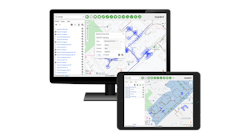5 Network Management Best Practices to Avoid It —
At the core of every service provider organization lies the network: a labyrinth of hardware and software that must operate at peak levels to ensure quality of service and customer satisfaction. It takes an army of trained engineers to build and maintain the skeleton that the rest of the organization depends on. It’s tempting, and sometimes necessary, to manage the network from the bottom up — but to quote the popular Star Wars character, Admiral Ackbar: "It’s a trap!"
Today, manage is no longer the operative word. The word that matters is monetize, and to do that you must take a top-down approach to network management. From a C-level perspective, here are 5 crucial business drivers that your network affects, and best practices to put into place to ensure monetization.
Business Driver 1: Design
Fiber records — not a sexy topic. But they can make or break you from a top-down perspective when the inevitable storm rolls through your town and you have subscribers without service, or when tracking necessary network expenditures to key projects. If you know that your fiber records are not 100% or you are embarking on a project to gather all existing outside plant (OSP) into a manageable work flow, then consider these practices to employ.
Best Practice 1: Begin with the end in mind.
Design in the system(s) you will use to manage the day-to-day operations. Use the same systems from Engineering to NOC to Customer Services.
If you’re in transition to a "one system workflow", then integrate crucial data wherever you can along the conversion.
Determine the master repository for each piece of information needed to manage network and design workflows and systems to match (i.e., one address from one repository flows to all systems. Fiber assignments live in one place and are accessible everywhere needed).
Pre-assign everything.
Standards are essential. There are as many ways to design a network as there are engineers to design them. Pick a model, pick a naming convention, pick a method of tracking, and STICK WITH IT. There will be many cases where short-term efficiency seems to dictate varying from the standard. This is usually a bad idea in the long term, so why risk it?
Keep up with the accuracy of your records, habitually. Records don’t seem that important until there are inventory issues, extended outages due to lack of fiber records, or capital expenditures are outpacing actual network growth. Attempting to compile records after these issues have become prevalent is a nearly impossible task.
Have a plan to seamlessly integrate these records into future subscriber billing records so all services, devices and logical network information can exist together.
Business Driver 2: Sales & Marketing
Network management best practices have a direct effect on sales and marketing. Expanding your network can be marketed effectively to bring in new customers. But a poorly deployed network can drain resources, limit new subscriber growth, and, worse, create churn when happy subscribers are suddenly dealing with network failures or stress.
Best Practice 2: Target well, deploy, and use cash flow as you go.
Estimate the cost of the network per area, and determine percent penetration needed to make area possible for construction.
Start only when your threshold is reached.
You may have subscribers that are interested in certain fiber services, but can’t receive those services yet. Track these commits in your system, and set a threshold of pledged subscribers to comply with the budget it takes to get them online.
Don’t move to the next area until you finish the one you are in.
Use ongoing incentives designed for new subscribers to refer other potential neighborhood subscribers to commit to your fiber services. This is an essential tactic to always stay in touch with your subscriber base, and to track trends and patterns.
Marketing and Engineering need to work together. Allow for tools that expose important engineering data to market campaign creators so they can immediately market what is being designed and planned.
Business Driver 3: Customer Service & Support
Obviously, your CSR team and your technical support team must work together to make sure your churn numbers stay low and customer satisfaction high. Have you empowered your CSR team to best answer service calls, route work orders properly, and schedule technicians? Do your technicians have access to all system data necessary to resolve customer satisfaction concerns? Are workforce management, outage management, installation and trouble ticket systems accessible from one main platform to easily arm your front line problem-solvers with vital information?
Best Practice 3: Reputation is everything.
Document every customer interaction in a single system, accessible to anyone that may interact with that same customer.
Manage quotas efficiently and leave room for emergencies. Don’t over-commit and keep people waiting too long.
Be proactive. Look for alarms, service fault patterns, repeat efforts and tickets, and address these, preferably with auto-notifications, before these trends become crises.
Use geo-spatial applications to help CSR and technical support teams visualize whole problems, and address and analyze them in the context of their region, area, and your entire footprint.
Develop and track specific exit code details for subscribers that churn to analyze competitor footprints. Set timed alerts (e.g., 11 and 23 months) to reach out and reclaim that subscriber’s business.
Business Driver 4: Capital Efficiency
Every deployed asset must generate revenue. This might sound far-fetched, but it is essential to top-down monetization and should be a core business practice to preserve your organization’s financials.
Best Practice 4: Track your hard assets to maximize utilization.
Develop automated, asset reclamation processes to identify no longer used and under-utilized equipment existing in the field or at a customer’s premises.
Don’t overlook the smaller unit-item purchases. Track and reclaim ONTs, pig tails, splitter cards, and all standard parts of an OSP fiber network.
Systematically analyze, groom, and re-groom PON port utilization.
Keep close watch on cable capacity percentages, and address capacity concerns far ahead of the need. This will enable you to design ways to combine or expand network areas efficiently in advance.
Business Driver 5: Demand Forecasting
Network growth must parallel subscriber growth. Demand forecasting and feasibility studies are crucial to start this process. A feasibility study will help evaluate and analyze the risks and costs associated with an expansion. It can preview the potential outcome, including alternatives and recommendations.
Best Practice 5: Do not overlook hidden costs of network expansion.
Economic Feasibility: Cost analysis and how it compares to potential revenue. Costs generally include planning and engineering, construction, equipment, backbone access, and operations.
Technical Feasibility: Assessment of technical requirements and constraints; current and future technology needs.
Schedule Feasibility: How long it takes to get the project completed, potential timeframes, and learning curve of potential new systems, and new technology.
Legal/Ethical Feasibility: Legal requirements, federal and state regulations that can affect the project;
Marketing Feasibility: Overview of target demographic, competitive presence analysis.
Geographical Information System and Demographic Data have emerged as necessary data sets of decision makers. Parcel data, utility account data, and total regional and area passings, are key data layers to deliver demand insight.
Network management is a constantly evolving challenge as engineers face technical migrations and conversions to implement new technology that is necessary to offer competitive services to subscribers. Managing from the top-down can make the most out of your most valuable asset: the network.





